Introduction
Pine trees are highly important to both Florida's ecosystems and its economy. There are seven species of native pines and each grows best in a particular environment. People have found varied uses for each species as well. Several species are of commercial value and are cultivated and managed to provide useful products such as paper, industrial chemicals, and lumber. Some species are also managed to enhance wildlife habitat and to provide attractive landscapes. Of course, many pines grow naturally. Unmanaged pine stands will produce mature trees and wildlife benefits, but, like any natural resource, may provide more benefits if managed wisely. This document gives an overview of the features and identification of the major pines found in Florida.
Biology
Pine trees are evergreens, which means that they keep their leaves and conduct photosynthesis year-round. The surface of the twigs is often rough from the presence of many small, brown, non-photosynthetic scales (Figure 1) spirally arranged along the stem. The adult leaves that emerge from the axil of each scale leaf are long, slender, green, and needle-like. When they are formed, the needles are generally bundled together in groups of two or more. Each bundle is called a "fascicle" and is held together by a collar of basal tissue called a "sheath." Needles are produced at the growing tips of the branches and remain on the tree for a number of years before turning brown and falling off.
Pine trees are also gymnosperms, which means that they belong to a diverse group of plants that reproduce with seeds but do not bear fruits or flowers. Pine reproduction is carried out by male and female cones, also known as "strobili." The male and female cones are separate structures, but both are present on the same plant. Pollen is produced by male cones and is carried by the wind to female cones where it fertilizes the ovules. Seeds develop and mature inside the female cones (also called the seed cones) for two years, protected by a series of tightly overlapping woody scales. Some pines open their seed cones after two years to release the seeds, while other pines continue to keep their cones tightly closed past maturity and release seeds in response to the heat of a forest fire.
Pine trees also produce chemical compounds called "oleoresins" that are used in manufacturing. The oleoresins can be collected through a labor-intensive process of removing a tree's bark and cutting slashes in the trunk. For many decades, beginning in the 19th century, the naval stores industry employed thousands of people and managed large pine plantations across the southeastern United States. Resin was collected primarily from slash and longleaf pines and was used to produce compounds for waterproofing wooden ships. The modern era of steel manufacturing that led to a decline in wooden shipbuilding also led to a correspondingly rapid decline in the naval stores industry. Today, most pine plantations in the southeastern United States are managed for the production of pulpwood and lumber.
Identification
The identification of pine trees requires careful attention to several key features. The choice of which parts to use for identification will depend on which parts are present and accessible on a particular specimen.
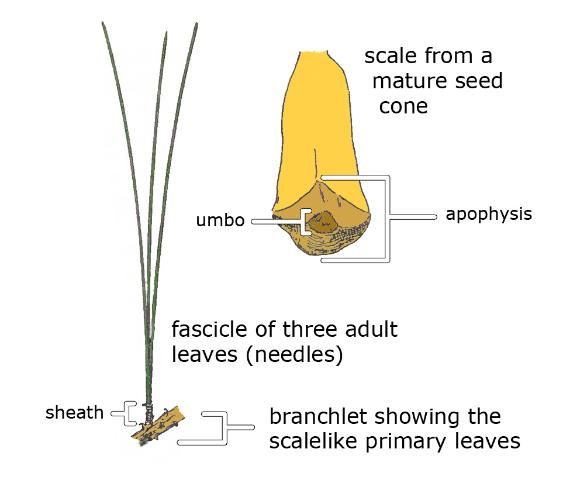
Credit: Original illustration in The Genus Pinus by George Russell Shaw (Publications of the Arnold Arboretum, 1914). Adapted and modified by Niels Proctor, UF/IFAS.
Needles are the most basic feature to check on a pine. Pay attention to their length and the number that are held in a fascicle. A handy rule of thumb is that pines starting with "S" have needles in twos, while pines starting with "L" have needles in threes. And slash pine, which starts with "SL" has needles in twos and threes.
Because the numbers per fascicle may vary, be sure to check several fascicles to get an overall sense for the plant! Unfortunately, because pine branches generally disappear from the lower trunk and are only found at the top of the tree, the green pine needles are often out of reach from ground level. If the pine is isolated, it is possible to use brown needles from the ground. Otherwise, be aware that the needles may actually have fallen from a different tree.
The size and surface texture of the bare twigs that have already lost their needles can be another important feature. Twigs from different species of pine can vary widely in thickness from thumb-sized to less than pencil-sized. The twig surface can vary from smooth to almost shaggy, depending on the size and persistence of the scale leaves.
Seed cones also offer strong clues for pine identification. All native pines in Florida are in the subgenus Pinus (the yellow or diploxylon pines). In this group, the outer (dorsal) surface of each seed cone scale has a diamond-shaped bulge, or "umbo," formed by the first year's growth (Figure 1). The umbo may or may not be armored with a "prickle," a sharp point but not quite a spine or thorn, at the tip. As the seed cone continues to grow and expand, the exposed area at the end of each scale grows as well. The larger diamond-shaped area around the umbo, formed in the second year of growth, is called the "apophysis." The shapes of the prickle, umbo, and apophysis can be helpful in identification. (But, again, be cautious about using cones on the ground to identify a pine unless you can be sure of which tree produced them.)
The part of a pine that is always available at ground level is the bark. Unfortunately, there is a wide range of variation in bark color and texture within a pine species. With time and experience it is possible to identify pine trees by the bark, but it would not generally be the best feature for beginners to use.
Table 1 lists many of the most important features for pine identification and describes how they should appear on the different species. Table 2 is a dichotomous key for the seven species of pine found naturally in Florida. Using the key, the chart, and these written descriptions, it should be possible for beginners to identify these species. Enjoy your exploration in the world of pines!
Native Pines
Loblolly Pine, Pinus taeda L.
Loblolly pine is common from Orange County in the central peninsula northward, except on wet ground or in sand pine scrub areas. It can occur on sandy sites underlain by clay, but it generally prefers good loam soil. Loblolly pine is also known as "old field pine" because it often invades abandoned agricultural fields. Recent genetic improvements on loblolly pine have made it the industry standard for planting in new pine plantations in Florida.
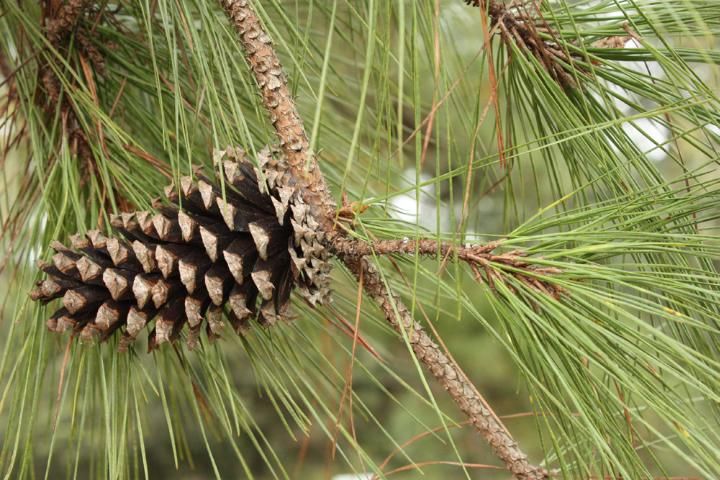
Credit: Niels Proctor, UF/IFAS.
The needles of loblolly pine can be anywhere from 3 to 9 inches (8–23 cm) long but are generally in a midrange of 5 to 6 inches (12–15 cm). They predominantly occur in fascicles of three, though bundles of two or four are occasionally found. They are rather stiff and sometimes slightly twisted. Seed cones are 2.5 to 4 inches (6–10 cm) long and persist on the tree until the end of the third year of their growth. Each umbo on the cone has a stout, sharp prickle. The bark of young trees is nearly black and scaly. Deep furrows appear on older trees, dividing the bark into irregular dark brown scaly blocks.
Loblolly pines may attain heights of 80 to 100 feet (25–30 m) and diameters of 1.5 to 4 feet (0.5–1.25 m). Branches in the high crown spread gracefully and may give a drooping appearance.
Loblolly pine is often confused with slash pine, but slash pine has a more even mix of two- and three-needled fascicles. The seed cones of slash pine are also a glossy caramel color with weak prickles, while loblolly cones are a dull brown with sharp, thick prickles. One of the most useful distinctions is that loblolly pine often has persistent cones from previous seasons, and they are held in groups of two or three, whereas slash generally only has the cones from the current season, and they appear individually.
Longleaf Pine, Pinus palustris Mill.
Before the arrival of European settlers and the advent of modern fire suppression practices, longleaf pine forests once covered upward of 60 million acres of the southeastern United States. The species was able to thrive in these areas because its lifecycle has evolved and adapted to withstand frequent low-intensity fires started by lightning. As a juvenile seedling, longleaf pine goes through a "grass phase" in which the only aboveground growth is a dense clump of grasslike needles. This phase can last anywhere from 3 to 20 years (most typically 5 to 7), and the tree uses the time to develop a root system and build up the energy supplies in its underground reserves. At the end of the grass phase, the tree grows very quickly, using the stored energy to rapidly gain height. The advantage of this approach is that it minimizes the amount of time when the growing tip of the plant is slightly above ground level and vulnerable to being killed in the hottest part of a forest fire.
Once a longleaf pine has gone through its adolescent growth spurt and developed thick bark, it is safe from ground-level forest fires and can grow at a slower pace. Longleaf pines may eventually reach heights of 80 to 100 feet (25–30 m) and diameters of 2.5 feet (0.75 m). Long boles (trunks) are topped by a small, open crown. The pendulous needles are borne three to a fascicle and are generally 8 to 12 inches (20–30 cm) long, although in some cases they can extend to even 18 inches (45 cm). The bare twigs below the needles are unusually stout ("thumb-sized") and have a rough surface where the older fascicles have fallen off. The winter buds at the tips of the branches are large, white, and upright, resembling candles on an enormous candelabra.
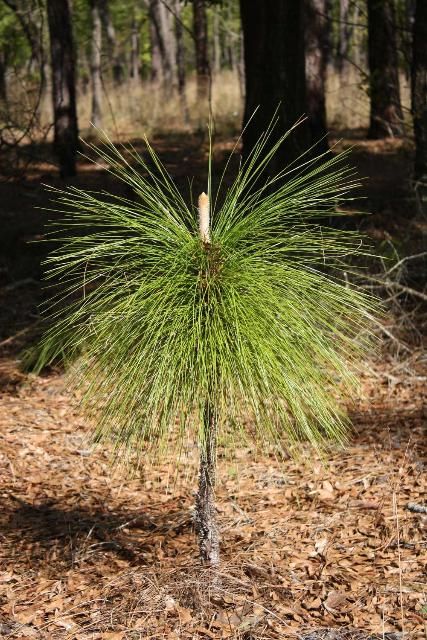
Credit: Niels Proctor, UF/IFAS.
Seed cones on longleaf pine range from 6 to 10 inches (15–25 cm) in length. The small prickle on each umbo is recurved, bending down toward the base of the cone. When the large cones fall from the tree, they generally leave a few scales on the branch.
The bark of longleaf pine is formed of thick, orange-brown plates. It provides fire resistance, as do the thick hairs found on buds when the tree is in its grass stage.
Longleaf pine is a common associate of turkey oak and is found naturally on flat, gravely and sandy soils. While stands of the longleaf pine turkey oak ecological community are found throughout Florida, they are most common in the central portion of the state north of Lake Placid and in the interior area of the panhandle. Like slash pines, longleaf pines were once a major part of the naval stores industry, but 200 years of logging and land clearing have greatly reduced the occurrence of this species. Some of the largest remaining contiguous stands of longleaf pine in Florida are in the Goethe State Forest near Ocala and on Eglin Air Force Base in the panhandle.
Restoration efforts are currently underway across Florida, and modern reforestation methods, including machine planting of containerized seedlings, are aiding in expansion of longleaf pine culture. In the future, we may expect to see more of these majestic trees in the Florida landscape.
Pond Pine, Pinus serotina Michx.
Pond pine is a native pine that is often overlooked or confused with loblolly pine. This close relative of the northern pitch pine grows in poorly drained flatwoods near bayheads and pond edges. (These forested wetlands are known locally as "pocosins," leading to the tree's other common name of "pocosin pine.") The tree is generally small and occasionally has a twisted or bent trunk. After a fire or other injury, the tree often sprouts tufts of needles (epicormic buds) from the trunk or root collar. This is one of the easiest ways to recognize this species.
The specific epithet in the scientific name for pond pine (serotina) is from the Latin word for "late" and refers to the late opening of the seed cones. For up to 8 years after maturity, the seed cones of pond pine will remain on the tree, tightly closed and holding their seeds. If a forest fire occurs in this interval, however, the cones will respond by quickly opening. According to the US Forest Service's Fire Effects Information System (FEIS), "Pond pine cones open and release seeds soon after exposure to heat from fire. Intensity of heat does not adversely reduce viability of seeds. Even badly charred cones release seeds that are capable of germination. Mature cones can be opened by exposure to 333 to 336 oF (167–169 oC) dry heat for 20 seconds or by immersion in boiling water for a similar period."[1]
Pine species with cones that open this way in response to fire are said to be "serotinous." Like the juvenile "grass phase" of longleaf pines, serotinous cones are an evolutionary adaptation to fire-prone environments. By releasing seeds in response to the heat of a forest fire, they allow a species to take advantage of the bare, exposed soil where germination and early growth is most likely to be successful.
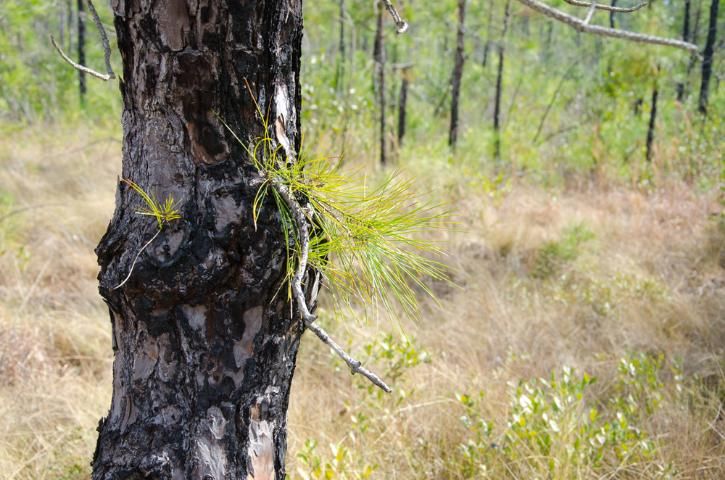
Credit: Flickr user Suzanne Cadwell.
The needles of pond pine are 5 to 6.5 inches (12–16 cm) long and occur primarily in fascicles of three, with some fascicles of two or four needles mixed in as well.
The cones of pond pine are 2 to 3 inches (5–8 cm) long and are sometimes described as "top-shaped" or "egg-shaped." Because of their persistence, they can make the trees look like a heavy seed producers.
Pond pine is not of particular value for wood products, but larger trees may be harvested for pulp.
Sand Pine, Pinus clausa (Chapm. ex Engelm.) Vasey ex Sarg.
As the common name would suggest, sand pine generally grows in very sandy, nutrient-poor soils. In Florida, it is found on both the Atlantic coastal sand dunes as far south as Dade County and on the Gulf coastal sand dunes as far south as Lee county. It also occurs in pure stands on the deep, dry, infertile acid sands of the state's interior, such as in the Big Scrub area of the Ocala National Forest, the world's largest area of sand pine.
Sand pine is a small- to medium-sized tree with a conical crown and persistent low, lateral branches. It grows in open stands, and the trunk and branches are frequently twisted, giving the trees a picturesque look. The twisted trunks and relatively small size make the trees unsuitable for timber. In addition, high levels of oils and other compounds may make this species less desirable for pulpwood. The wood is therefore primarily used for fuel and firewood.
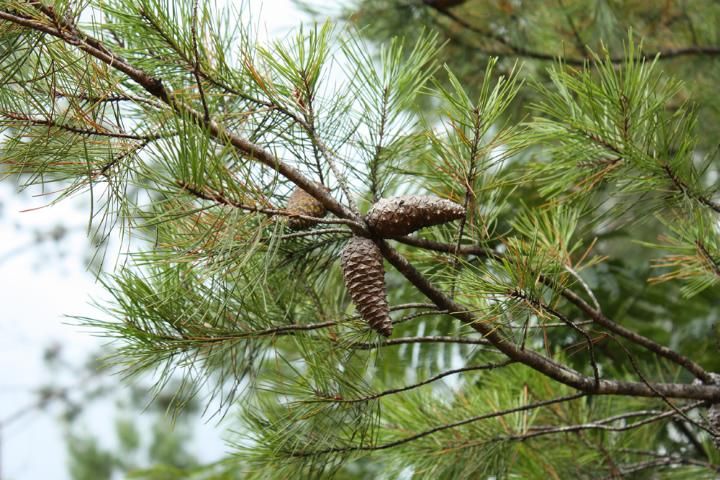
Credit: Niels Proctor, UF/IFAS.
Young sand pines have smooth trunks with thin bark that can vary in color from brown to tan to gray. The bark of large trees remains fairly smooth, particularly near the top. The needles are 2 to 3 inches (5–8 cm) long and are generally borne in fascicles of two. Sand pine twigs are many-branched, smooth, and slender. Mature cones are about the same length as the needles, 2 to 3 inches (5–8 cm) long, and often grouped in clusters. They may persist on the tree for many years open or unopened.
Two varieties of sand pine are recognized in Florida. Choctawhatchee sand pine (var. immuginata) has cones that open at maturity. Ocala sand pine (var. clausa) has cones that remain closed until fire sweeps through the stand. Choctawhatchee sand pine is a common choice for reforestation projects on deep sands because it survives transplanting well. The genetically improved Choctawhatchee sand pine is best for Christmas trees and may be sheared and shaped effectively.
Shortleaf Pine, Pinus echinata Mill.
Shortleaf pine is a common tree found on dry hills and upland areas across most of the southeastern United States, but its natural range in Florida is restricted to a very small area in the panhandle, from the Aucilla River westward to Okaloosa County. (To avoid confusion, remember that any short-needled pine in a natural setting east of the Suwannee River is not shortleaf!)
Mature shortleaf pines have a tall, straight trunk with branches that tend to be winding or sinuous. The bark of older trees has distinctive flat, reddish-brown plates that resemble jigsaw puzzle pieces. Many small resin pockets (approximately 1 mm in diameter) may be scattered throughout the bark. The scientific name for the species comes from the ancient Greek word for "hedgehog" (ekhînos) and refers to the short shoots that develop off the trunk and larger branches, giving the tree a "prickly" appearance.
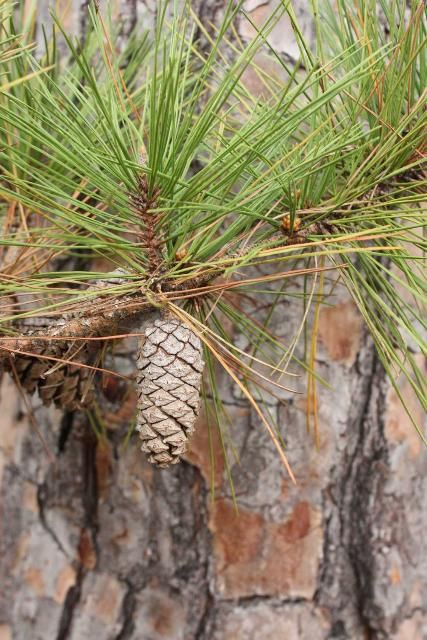
Credit: Niels Proctor, UF/IFAS.
The twigs of shortleaf pine are slender and rough. Needles are 2.75 to 4.5 inches (7–11 cm) long and are predominantly in fascicles of two, with some fascicles of three. Most needles on each tree are fairly uniform in length, but needle length from tree to tree varies more than in any other native pine in Florida. The cones of shortleaf pine are only 1.5 to 2.5 inches (4–6 cm) long (the smallest of any native pine in Florida), and the thin scales cause them to be flexible when open. They appear in clusters and persist on the tree for several years after opening.
In the Florida panhandle, P. echinata and P. glabra (spruce pine) are sometimes confused because both sometimes occur as old trees in mixed hardwood stands. The two species can be distinguished most easily by the differences in the bark and in the surface of the twigs.
Slash Pine, Pinus elliottii Engelm.
Slash pine was once the common tree of pine plantations throughout Florida. Over the past century, millions of acres of slash pine have been planted, grown, and harvested. It takes about 30 years for slash pine trees to reach sawtimber size. Younger trees are harvested for pulpwood, while older trees are used for lumber. In recent years, foresters have begun to plant more loblolly than slash, but plantations of slash are still very common.
Historically, slash pine was (with longleaf pine) one of the two primary sources of resin for the production of turpentine and rosin by the naval stores industry. Using the "Herty system," workers would remove a section of bark and cut an angled slash or "streak" in the wood of the tree. Below the streak, an angled piece of galvanized metal was attached to direct the oozing resin into a tin cup. When one streak stopped producing resin, a new one would be cut directly above the first. Eventually the tree could have several rows of parallel slashes up its trunk. The naval stores industry has all but disappeared in Florida, but slash pines with persisting "cat-face" scars from the resin harvesting can still be found in many old stands.
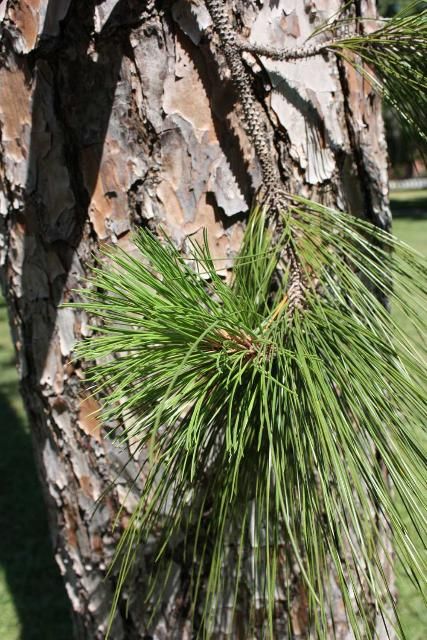
Credit: Niels Proctor, UF/IFAS.
The needles of slash pine can be anywhere from 4 to 10 inches (10–25 cm) long, but are most commonly in the range of 8 to 10 inches (20–25 cm). The fascicles are a mixture of twos and threes. The twigs are rough and are generally crowded with fascicles at the end, producing large "brooms" of needles. The cones are 2.75 to 6 inches (7–15 cm) long and glossy brown or caramel-colored.
While slash pine is widely planted, it also occurs naturally in wet flatwoods, swampy areas, and shallow pond edges. Slash is sometimes found growing with loblolly pine (Pinus taeda). Distinguish between the two by looking for loblolly pine characteristics: loblolly pines always grow with three needles per fascicle, loblolly cones persist on the tree for a longer time than slash pine cones, and the prickles on the cones of loblolly pine are thicker and stiffer than those on the cones of slash pine.
There are two recognized varieties of slash pine. The variety found throughout most of the state (Pinus elliottii var. elliottii) is the one described above. South Florida slash pine (Pinus elliottii var. densa) is a variety found in the very southernmost parts of the state. It differs morphologically in that it has smaller cones and longer needles that are concentrated in fascicles of two. It is also different from the northern variety in that it goes through a juvenile "grass phase" similar to that of longleaf pine (Pinus palustris). The largest remaining stand of South Florida slash pine is on Big Pine Key in the Florida Keys.
Spruce Pine, Pinus glabra Walter
Spruce pine is a short-needled pine found in hardwood hammocks from Alachua County northward and westward into the panhandle. The trees prefer moist, sandy loam soils and can reach heights of 80 to 115 feet (25–35 m). They are not generally abundant, but may be found scattered among loblolly pines and hardwoods in hammocks, or along stream banks. The common name comes from the distinctive silvery-gray bark of older trees that resembles the bark of spruce trees (Picea spp.).
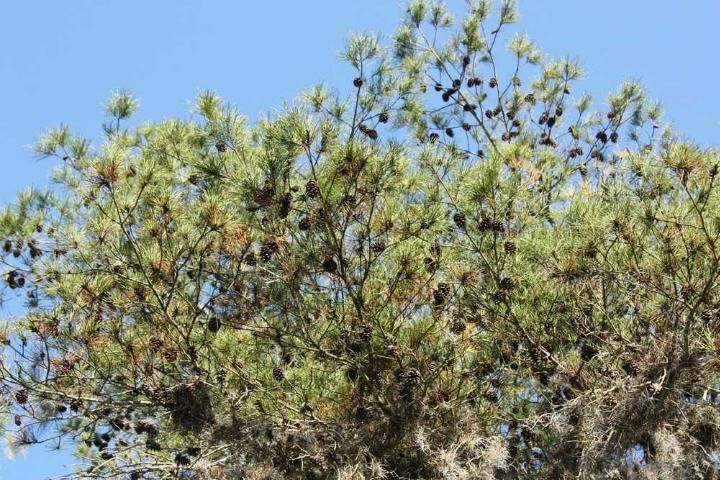
Credit: Niels Proctor, UF/IFAS.
Needles of spruce pine are 3.5 to 4 inches (9–10 cm) long and spirally twisted. They grow very consistently in fascicles of two. Older twigs that have lost their needles are smooth and thin. The seed cones are small, only 1.5 to 3 inches (4–8 cm) long, and usually solitary. They open promptly to release the seeds at maturity but then persist on the tree for several years.
This species is the most shade tolerant of our native pines, and full sun may retard its growth. It can tolerate brief flooding but not continually waterlogged soil.
Introduced Pines
Worldwide, there are around 175 species of pine and hundreds of additional named cultivars. It would be impossible to list all of the introduced pines that can be currently found growing in Florida, but here are a few of the more common ones. (For more detailed information on cultivated pines, see the list of "suggested reading" at the end of this document.)
Japanese Black Pine, Pinus thunbergii Parl. [syn: P. thunbergiana Franco]
Japanese black pine is indigenous to Japan, where in its native habitat it may grow as tall as 130 feet (40 m). In the United States, it is planted as a landscaping ornamental in USDA zones 6 through 8b, which means that its use in Florida is restricted to the panhandle.
One reason for the popularity of this species is its relative salt tolerance. It may be planted successfully in oceanside areas, where the ocean wind often contorts the trunk and branches into a "windswept" shape that resembles a large bonsai specimen. In the United States it is useful as a roadside planting where highways are salted for ice removal.
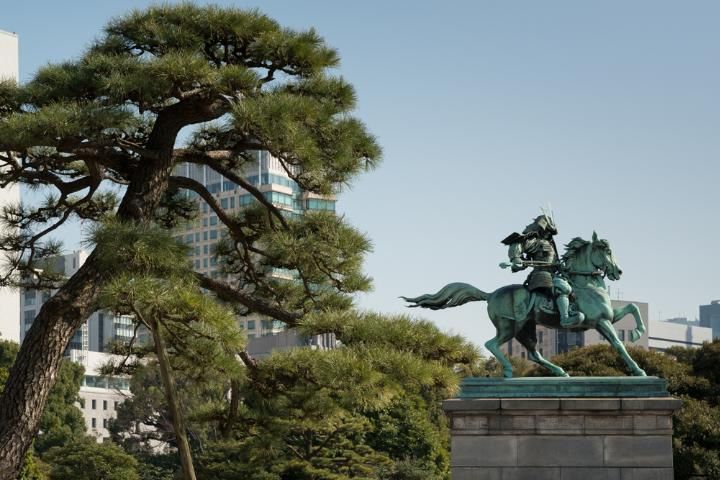
Credit: Flickr user Ross Fowler.
The shrub-like branching and stocky habit of the Japanese black pine makes the species ideal for living screens and barriers. Individual specimens provide a focal point for planters, entrances, and oriental gardens. Dwarf cultivars such as 'Thunderhead' are sometimes used when the tree is planted in confined spaces.
Needles of the Japanese black pine are bright green, 3 to 4.5 inches (8–11 cm) long, and grouped in pairs. They are stout and sharp pointed when compared with other pines of Florida. Cones are round to cone shaped and approximately 1.5 inches (4 cm) long.
Virginia Pine Pinus virginiana Mill.
The native range of Virginia pine is limited to the eastern United States, more specifically to the Piedmont and foothills of the Appalachian Mountains. Growers in Florida have experimented with using this species for Christmas tree production, but the performance has generally been low.
Although this pine grows on a variety of soils, it grows best in moderate- to well-drained clay, loam, or sandy soils. Compared to other pines it is slow-growing and short-lived. If grown in the open, the crown is quite irregular, with sporadic branching often making the plant shrub-like in appearance. Virginia pine is a small to medium sized tree, rarely over 50 feet (15 m) tall. Like sand pine, it does not self-prune and may have many dead branches below the live crown. Bark of the Virginia pine is thin and smooth on young trees and on older trees is broken into dark-brown, plate-like scales separated by shallow fissures. The upper trunk and larger limbs are covered with orange-brown, papery scales.
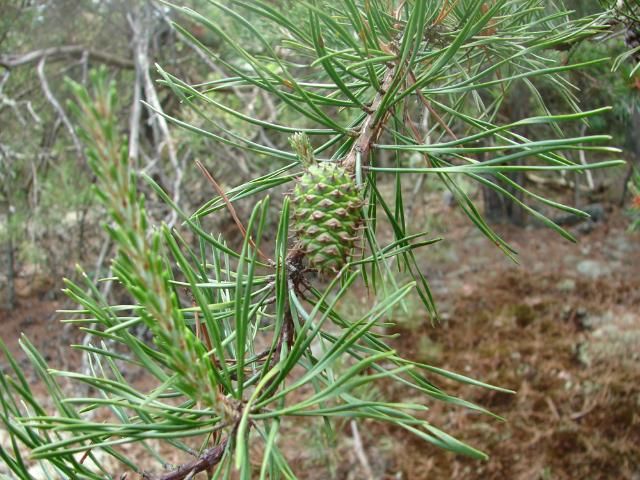
Credit: Flickr user Martin LaBar.
Virginia pine needles are dark yellow green, slightly to strongly twisted, and bound in fascicles of two. They are approximately 1.5 to 3 inches (4–8 cm) long and relatively thick in relation to their length. The seed cones are small, also about 1.5 to 3 inches (4–8 cm) in length, and have a distinctively "prickly" appearance from the long, slender, needle-like spine on each scale.
Pine "Lookalikes"
There are a few trees in Florida that have "pine" in the common name and are often mistaken for pines, although they are not actually members of the genus Pinus.
Australian Pine, Casuarina spp.
"Australian pine" is the common name given to several different species in the genus Casuarina. These plants are not conifers (or even gymnosperms) but they get their common name from the slender, green, needlelike branchlets that do most of the photosynthesis for the plant. The branchlets are jointed stems that can be easily pulled apart into segments, and the true leaves appear as small "teeth" in whorls at each joint.
These trees are native to Australia and were originally planted in Florida for erosion control, landscaping, and possible use as timber. Unfortunately, it was quickly apparent that the plants could invade and disrupt natural plant communities. Using a combination of heavy shade and dense surface roots, these trees can crowd out other vegetation and lead to dense, monoculture stands.
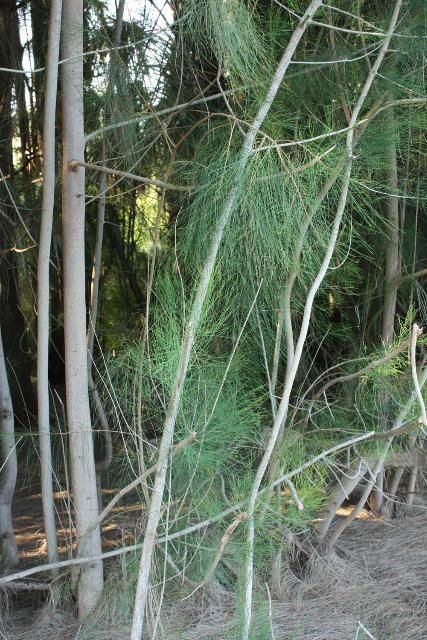
Credit: Niels Proctor, UF/IFAS.
Of the Casuarina species that are currently found in Florida, two—C. equisetifolia and C. glauca—are on the state's noxious weed list. Those two species are also listed as Category I invasives by the Florida Exotic Pest Plant Council (FLEPPC). The Category I listing means that these plants are "invasive exotics that are altering native plant communities by displacing native species, changing community structures or ecological functions, or hybridizing with natives." A third species, C. cunninghamiana, is currently listed by FLEPPC in Category II, which denotes "invasive exotics that have increased in abundance or frequency but have not yet altered Florida plant communities to the extent shown by Category I species."
Because these species have a high salt tolerance, they are generally found in coastal areas. In Florida, heavy infestations are common in the Keys and along the southern edge of the peninsula, spreading north to Tampa on the Gulf Coast and to Melbourne on the Atlantic Coast. Isolated stands can be found as far north as Tallahassee and Jacksonville.
Norfolk Island Pine, Araucaria heterophylla (Salisb.) Franco
Norfolk Island pine is a conifer in the family Araucariaceae. It is found naturally only on Norfolk Island, a small island in the south Pacific near Australia and New Zealand. The foliage is waxy and variably bright to dark green. Individual leaves are only 0.5 to 0.75 inches (1–2 cm) long and claw-like, but not sharp. The tree is striking at least in part because of its symmetry, with regular whorls of branches around a single straight trunk.
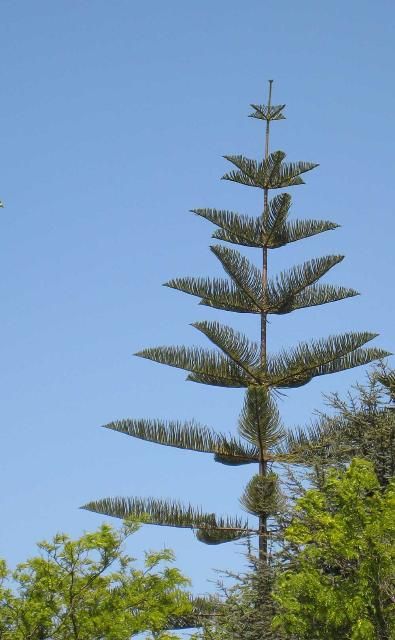
Credit: Flickr user nautical2k.
Because of its intolerance for cold weather, Norfolk Island pine cannot grow outdoors in most of the United States. In Florida, however, it can grow in coastal areas in the southern half of the state. Florida is also a major producer of small, container specimens of the plants, which are shipped across the country to be sold as houseplants or living Christmas trees.
Other interesting and unusual trees in the same genus include the bunya-bunya (Araucaria bidwillii) and the monkey puzzle tree (Araucaria araucana).
Suggested Reading
For more information on growing and identifying pine trees in Florida, you may want to consult the following references.
Dirr, M. 2002. Dirr's trees and shrubs for warm climates: an illustrated encyclopedia. Portland, Or: Timber Press.
Florida Forest Service. 2013. Forest Trees of Florida. (FDACS-P-01566).
Krüssmann, G., G. S. Daniels, and H. D. Warda. 1985. Manual of cultivated conifers (T. Press, Trans. 2nd, revised ed.). Portland, Oregon: Timber Press.
Nelson, G. 2011. The trees of Florida: a reference and field guide (2nd ed.). Sarasota, Fla: Pineapple Press.
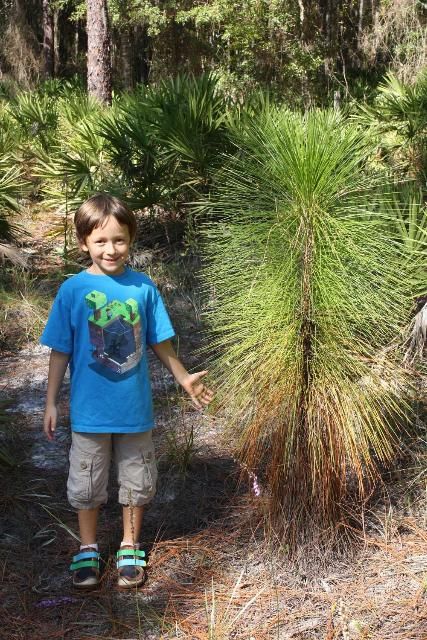
Credit: Niels Proctor, UF/IFAS.

Publication History
FOR-21, Common Pines of Florida, was originally written by Nancy P. Arny and D.M. Flinchum, incorporating information from FRC-21, Native Pines of Florida (November 1981). It was first published in print format February 1989 and revised March 1992, June 1994, and June 1995. The 1995 revision was distributed online from 1997 until 2013. Archived version: http://ufdc.ufl.edu/IR00001805/00001